Fuji FinePix S9000By: Dave EtchellsFuji's latest bridge camera offers a larger, 9.0-megapixel SuperCCD HR imager with a high resolution electronic optical viewfinder. <<Video, Power, Software :(Previous) | (Next): Reference: Datasheet>> Page 12:Test Results & ConclusionReview First Posted: 12/14/2005 |
We ran the Fujifilm FinePix S9000 through our usual battery of tests, and have summarized our findings here. To see the full set of our test images, with explanations of what to look for in them, see the Fujifilm FinePix S9000 Sample Pictures page. For a complete listing of all our test and "gallery" shots, go to the Thumbnails page.
A collection of more random, pictorial images can be found in the FinePix S9000 Photo Gallery.
Not sure which camera to buy? Let your eyes be the ultimate judge! Visit our Comparometer(tm) to compare images from the Fuji S9000 with those from other cameras you may be considering. The proof is in the pictures, so let your own eyes decide which you like best!
Lens
Zoom
An excellent 10.7x optical zoom range, with good performance.
|
28mm |
300mm |
2x Digital Zoom |
The Fuji S9000 zooms over the equivalent of a 28-300mm range, a very generous zoom range for its class. Results are good at wide angle, with sharp details, though some coma distortion and flare is noticeable in the leaves against the sky in both upper corners. The 2x digital zoom actually performs better than one might expect, with low noise and only moderate blurring, but as always, digital zoom is basically just cropping-out the central pixels of the sensor's image. Details remain fairly sharp with the digital zoom enabled.
Macro
A larger than average macro area in the normal mode, but a tiny area in Super Macro. Flash exposes fairly well in normal macro mode.
| Standard Macro | Macro with Flash | Super Macro |
The Fuji FinePix S9000's normal macro setting did OK in our test, but it captured a larger than average minimum area measuring 5.02 x 3.76 inches (127 x 96 millimeters). The camera's Super Macro setting captured a much smaller area, a very small 1.48 x 1.11 inches (38 x 28 millimeters), but the close shooting range made lighting difficult. Detail was strong and resolution high, with only a moderate amount of softening in the corners from the lens. (Most cameras have some softening in the corners in macro mode.) The flash throttled down pretty well, but obviously can't do much in Super Macro mode due to the very short shooting distance.
Distortion
Moderate barrel distortion at wide angle, low pincushion at telephoto.
This is the tendency for the lens to bend straight lines outward (like a barrel--usually at wide angle) or inward (like a pincushion--usually at telephoto). The Fujifilm FinePix S9000's 0.8% barrel distortion at wide angle is about average among the cameras I've tested, although I personally feel that this level is too high. At the telephoto end, the S9000's 0.1% pincushion is low. (It's worth noting that the S9000 manages to stay within the typical range of distortion for cameras we've tested, despite its more than 10x zoom ratio, an impressive achievement.)
| Barrel distortion at 28mm is 0.8% |
| Pincushion at 300mm is 0.1% |
Chromatic aberration
High to moderate in the corners of the images. Worst at wide angle, slightly better at telephoto.
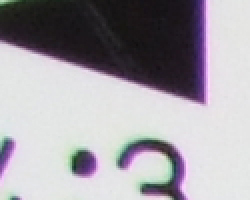 |
 |
| Wide: High and bright, top left @ 200% |
Tele: Less bright but still high, top left @200% |
Chromatic aberration is rather high at wide angle, showing about 7-8 pixels of very bright coloration on either side of the target lines. The effect decreases only slightly at telephoto focal lengths, but is in the opposite direction. (The green fringes are towards the outside edges of the frame at wide angle, but toward the center of the frame at telephoto.) At intermediate focal lengths, the chromatic aberration decreases and passes through zero. (This distortion is visible as a very slight colored fringe around the objects at the edges of the field of view on the resolution target.) Overall, the chromatic aberration from the Fuji S9000's lens is higher than we'd like to see at both ends of its zoom range, but does decrease to a acceptable level over a broad range of intermediate focal lengths.
Corner Sharpness
Fairly strong softening in the top corners of the frame, strongest effect in the upper right corner. Lower corners soft, but effect not as strong.
The Fuji S9000 produced soft corners in a few shots, the upper right corner being by far the worst. (Perhaps the sensor chip in our sample was slightly tipped up in that corner? - Non-planar sensor chips are a surprisingly common problem in digital cameras.) Apart from that particularly problematic corner though, sharpness in the corners of the frame was noticeably better than average, even when shooting at maximum aperture, as seen above. (As we saw earlier though, chromatic aberration is fairly evident in these tests.)
Sensor
Exposure and White Balance
Indoors, incandescent lighting
Excessive warm cast with both Auto and Incandescent white balance settings, but Manual option produced very good results. More exposure compensation required than usual, but Incandescent white balance required less.
| Auto White Balance +1.3 EV | Incandescent WB +0.7 EV |
| Manual White Balance +1.3 EV |
Color balance indoors under incandescent lighting was quite warm in Auto and Incandescent white balance modes, but the Manual setting produced much more accurate results. The FinePix S9000 required a +1.3 EV exposure compensation boost to get a good exposure, which is higher than average for this shot. (Though the Incandescent white balance looked best at +0.7 EV, a puzzling variation.) Overall color with the manual setting looks good, if a little reddish, though the blue flowers are dark and purplish. (A very common outcome for this shot.) Our test lighting for this shot is a mixture of 60 and 100 watt household incandescent bulb, a pretty yellow light source, but a very common one in typical home settings here in the US.
Outdoors, daylight
Good overall color balance, though a hint red. Good color and average to a bit better than average exposure accuracy.
| Auto White Balance, +0.3 EV | Auto White Balance, Auto Exposure |
Outdoor shots generally showed fairly accurate exposure, though highlights were easily blow-out and the deep shadows lost some detail. The Fuji FinePix S9000 generally required less exposure compensation than average outdoors as well. Color is quite good, vivid without appearing at all overdone, although bright yellows and greens were a bit more muted than with many consumer-level digital cameras.
See full set of test images with explanations
See thumbnails of all test and gallery images
Resolution
Very high resolution, 1,600 lines of strong detail.
Our laboratory resolution chart revealed sharp, distinct line patterns down to about 1,600 lines per picture height, with extinction past 2,000. (Some reviewers will doubtless argue for higher numbers, but past 1600 lines, the level of artifacts and aliasing starts to swamp the target detail itself.) Use these numbers to compare with other cameras of similar resolution, or use them to see just what higher resolution can mean in terms of potential detail. Beware that while you might be able to make out what looks like distinct lines at numbers higher than those we've mentioned here, the camera is just doing its best to continue interpreting the lines. If you zoom in and follow them from the wider portions, you'll see the lines converge and reappear a few times at the higher numbers.
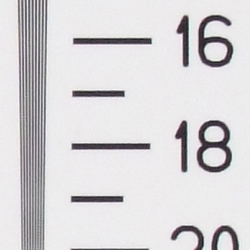 |
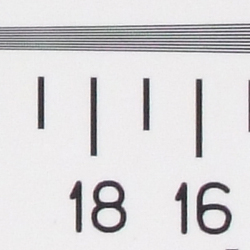 |
| Strong detail to 1,600 lines horizontal | Strong detail to 1,600 lines vertical |
See full set of test images with explanations
See thumbnails of all test and gallery images
Sharpness & Detail
Fairly sharp images, with some blurring of detail from noise suppression.
The Fujifilm FinePix S9000's images are quite sharp, with relatively little over-sharpening or excessive edge enhancement on the camera's part. (Edge enhancement creates the illusion of sharpness by enhancing colors and tones right at the edge of a rapid transition in color or tone.) Though some edge enhancement is at play here, results are still very good, and the camera's images take strong/tight unsharp masking in Photoshop(tm) very well. (Try 200% at an 0.3 pixel radius to bring out lots of fine detail.
Noise-suppression systems in digital cameras tend to flatten-out detail in areas of subtle contrast. The effects can often be seen in shots of human hair, where the individual strands are lost and an almost "watercolor" look appears, but is also frequently found in shots of foliage. The crop at top right shows this somewhat, with darker areas of Marti's hair showing only slightly limited detail, though is still good here. You can also see areas in the pine foliage of the crop above left where the subtle detail is just missing altogether. (The level of detail loss shown here isn't all that obvious on prints 8x10 inches or smaller though.)
ISO & Noise Performance
Low noise at the normal sensitivity settings, though very high noise that blurs detail at the higher settings.
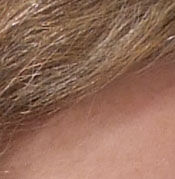 |
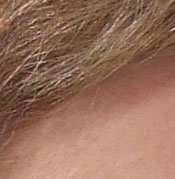 |
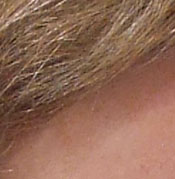 |
| ISO 80 | ISO 100 | ISO 200 |
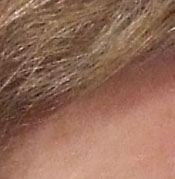 |
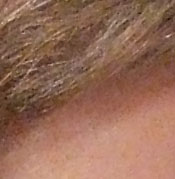 |
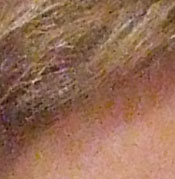 |
| ISO 400 | ISO 800 | ISO 1,600 |
The Fuji S9000's lower ISO settings produced low to moderate noise, with only slightly blurred detail in areas of subtle contrast. As the ISO setting increased, so did the noise level and the amount of blurring caused by the noise reduction processing. Images at ISO 400 are visibly soft on-screen, but still look surprisingly crisp when printed at 8x10 inches. At ISOs 800 and 1,600, noise is so high that the pixels give the image a pointillist effect, almost like a Seurat painting. At a print size of 8x10 inches and a normal viewing distance of a foot or so, the graininess of ISO 800 shots is noticeable but probably acceptable, while ISO 1600 shots are really unusable at that size. Dropping down to 5x7 inches, ISO 800 shots are still a little grainy looking, but should be acceptable to most users, while ISO 1600 shots are still very rough. Printed as 4x6 inch snapshots, the ISO 1600 images finally become usable, but still look a bit rough and have a visibly different color balance resulting from all the noise pixels.
Extremes: Sunlit and low light tests
High resolution with good overall detail, but slightly high contrast limits both shadow and highlight detail. Excellent low-light performance, capable of capturing bright images under average city street lighting and darker.
| Normal | +0.3EV | +0.7EV |
Sunlight:
Because digital cameras are more like slide film than negative film (in that they tend to have a more limited tonal range), we test them in the harshest situations to see how they handle scenes with bright highlights and dark shadows, as well as what kind of sensitivity they have in low light. The shot above is designed to mimic the very harsh, contrasty effect of direct noonday sunlight, a very tough challenge for most digital cameras. (You can read details of this test here.)
The FinePix S9000 handled the above challenge fairly well, but its somewhat high contrast resulted in limited highlight and shadow detail. The effect of noise suppression is visible in the deep shadows, and does contribute to the moderate loss of detail here. The default exposure preserved the strong highlights in this shot, but the +0.3 EV image is just a bit brighter and better-looking overall, despite the loss of highlight detail. (In "real life" though, be sure to use fill flash in situations like the one shown above; it's better to shoot in the shade when possible.)
Low light:
The Fujifilm FinePix S9000 performed very well here, capturing bright images even at the lowest light levels. Color balance looked good with the Auto white balance setting. The camera's autofocus system worked unusually well, able to focus on the subject almost down to the darkest light levels we test at, even with its AF-assist light turned off. (About 1/8 foot-candle, roughly 1/8 as bright as typical city street lighting at night, as long as the camera and subject were both motionless.) With AF-assist on, the camera easily handled the darkest level we test at.
NOTE: This low light test is conducted with a stationary subject, and the camera mounted on a sturdy tripod. Most digital cameras fail miserably when faced with a moving subject in dim lighting. (For example, a child's ballet recital or a holiday pageant in a gymnasium.) For such applications, you may have better luck with a digital SLR camera, but even there, you'll likely need to set the focus manually. For information and reviews on digital SLRs, refer to our SLR review index page, or see the Dave's SLR Picks, for some of our favorite models.
Color
Saturation & Hue Accuracy
Slight oversaturation in bright reds and blues, though good overall color and hue accuracy.
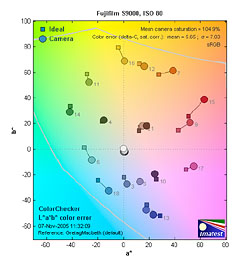 |
| In the diagram above, the squares show the original color, and the circles show the color that the camera captured. More saturated colors are located towards the periphery of the graph. Hue changes as you travel around the center. Thus, hue-accurate, highly saturated colors appear as lines radiating from the center. |
The other important part of color rendition is hue accuracy. Hue is "what color" the color is. Here, the Fuji S9000 also performed fairly well. Depending on the white balance setting, the S9000 had a tendency toward slightly reddish or slightly warm overall color, often resulting in deep blues in the flower bouquet. On the color error chart above right, we see that, as with most digital cameras we test, the S9000 shifts cyans towards pure blues, a very common tactic to improve sky colors. Orange hues are shifted slightly towards pure reds, but all other colors are quite hue-accurate.
Our random "Gallery" shots showed very pleasing color across a wide variety of subjects. (See our Fujifilm FinePix S9000 Photo Gallery for more shots taken with the camera.)
Viewfinder
Coverage
Very good accuracy with the LCD monitor and electronic optical viewfinder.
| 28mm eq., LCD monitor | 300mm eq., LCD monitor |
The Fuji S9000's electronic optical viewfinder and LCD monitor showed essentially identical results, at close to about 100 percent frame accuracy for both zoom settings, though my standard measurement lines were just out of frame in the final shot.
Flash
Coverage and Range
The FinePix S9000's flash has a limited range, and produces a slight blue cast in combination with typical incandescent room lighting. However, our standard shots required a little less exposure compensation than average.
| 28mm equivalent | 300mm equivalent |
| Normal Flash +0.7 EV | Slow-Sync Flash +0.7 EV |
Flash coverage was slightly uneven at wide angle, with a small shadow in the lower portion of the frame from the lens. At telephoto, results were quite dim. In the Indoor test, the flash on the Fuji S9000 underexposed our subject at its default setting, requiring a +0.7 EV exposure compensation adjustment to get reasonably bright results. Even here, the exposure is a little dim, with a strong orange cast. The camera's Slow-Sync flash mode produced only slightly brighter results, though with a stronger pinkish-orange cast from the room lighting. The Slow-Sync flash also required a +0.7 EV exposure adjustment for bright results.
| 8 ft | 9 ft | 10 ft | 11 ft | 12 ft | 13 ft | 14 ft |
1/60 sec f3.8 ISO 100 |
1/60 sec f3.9 ISO 100 |
1/60 sec f4.0 ISO 100 |
1/60 sec f4.0 ISO 100 |
1/125 sec f4.1 ISO 100 |
1/125 sec f4.2 ISO 100 |
1/125 sec f4.4 ISO 100 |
Even at eight feet, our closest test range, the S9000's flash underexposed the target somewhat. Flash power continues to decrease with each additional foot of distance, becoming quite dim at 14 feet.
Output Quality
Print Quality
Excellent print quality, good color, very good 13x19 inch prints. ISO 400 images are very soft at 8x10, acceptable at 5x7, great at 4x6.
Testing hundreds of digital cameras, we've found that you can only tell just so much about a camera's image quality by viewing its images on-screen. Ultimately, there's no substitute for printing a lot of images and examining them closely. For this reason, we now routinely print sample images from the cameras we test on our Canon i9900 studio printer, and on the Canon iP5200 here in the office. (See the Canon i9900 review for details on that model.)
The Fujifilm FinePix S9000 produced very crisp-looking 13x19 inch prints on our i9900 printer. We've observed in the past that Fuji's SuperCCD sensor technology really shines in printed output, more so than when viewed on-screen, and the S9000 once again proves that out. Even 13x19 inch prints stood up very well to close inspection, appearing sharper than we'd normally expect 9-megapixel prints to look when printed at that size.
As noted above, the S9000 does fine at lower ISO settings, but its image quality degrades fairly rapidly above ISO 400. ISO 800 shots will probably be usable as 8x10 inch prints for most folks interested in displaying them on a wall or table, where they won't be scrutinized too closely. At 5x7 inches, ISO 800 shots are still a bit grainy, but should be satisfactory for most users. At ISO 1600 though, the noise is so high that the resulting images really shouldn't be considered for use printed any larger than 4x6 inches, and even there the color balance of the images may shift due to the large amount of blue-channel noise.
Color-wise, the S9000's images looked very nice when printed on the i9900, with color that managed to appear bright enough to be pleasing, without appearing at all oversaturated. Skin tones were very natural in daylight conditions, and became only slightly reddish under incandescent lighting, when using the manual white balance option. All in all, a very nice performance, resulting in very high-quality prints.
Timing and Performance
Fujifilm FinePix S9000 Timing
Good to average speed for a consumer camera.
| Startup/Shutdown: | |
| Power On to first shot | 0.9 seconds |
| Shutter response (Lag Time): | |
|
Full Autofocus Wide |
0.67 second |
|
Full Autofocus Tele |
0.65 second |
|
Full Autofocus Tele (High Speed Mode) |
0.43 second |
|
Prefocused |
0.011 second |
| Cycle time (shot to shot) | |
| Normal large/fine JPEG | 1.20 seconds |
| Flash recycling | 8 seconds |
| Continuous mode | 0.91 second 1.10 frames/second (7 large/fine frames) |
| Continuous mode, Top 4 mode |
0.61 second 1.65 frames/second (4 large/fine frames) |
| Download speed | |
| Windows Computer, USB 2.0 | 4,323 KBytes/sec |
The FinePix S9000's performance ranges from moderately fast to just average, depending on what you're trying to do. It starts up fairly quickly, and has a reasonable quick shutter response when the lens is set to both zoom positions. Its "High Speed" autofocus mode makes a considerable difference though. By limiting the focusing range to a minimum of several feet, the shutter lag drops to a very fast 0.43 second. Finally, if you "prefocus" the camera by half-pressing and holding down the shutter button before the final exposure, it's blazingly fast, with a shutter delay of only 0.011 second, among the fastest on the market. Shot to shot cycle times are a little better than average, at about 1.2 seconds for large/fine JPEGs, and it can capture as many as eight shots this quickly (when using an xD Picture card) before it has to slow down and wait for the memory card to catch up.
As noted in our full-length performance tests earlier in the review, the S9000 is also quite a bit faster when writing to xD Picture cards than it is with every very fast CompactFlash cards. This won't affect its shot to shot time before the buffer memory fills, but the buffer will empty more than twice as fast with an xD than a CF card, effective buffer capacity is over twice as great, and RAW-mode cycle times are 25% better when using an xD card.)
Continuous-mode speed is somewhat slow for this class of camera, at a bit over one frame/second, for up to seven shots in succession, but its "Top 4" mode is faster, at 1.65 frames/second. The flash takes about eight seconds to recharge after a full-power shot, about average for this class of camera. Connected to a computer, download speeds are exceptionally fast.
Bottom line, the S9000 is responsive enough to handle most normal photo opportunities, though sports photographers may want a more responsive camera in terms of continuous shooting.
Battery and Storage Capacity
Battery
Good battery life with either the LCD or EVF viewfinders.
|
|
|
| Still-image capture mode LCD on |
181 minutes |
| Still-image capture mode LCD off |
177 minutes |
| Image playback LCD on |
466 minutes |
The FinePix S9000 uses four AA-type batteries for power. The table above shows maximum run times based on our power measurements and the rated performance of its battery. These are excellent battery-life numbers, but our standard recommendation of buying a couple of sets of high-capacity NiMH cells and a good-quality charger still stand.
Storage
A (totally inadequate)16MB xD Picture Card is included with the FinePix S9000, although it also accepts CompactFlash cards.
|
16MB xD Picture Card |
RAW | Fine | Normal | |
| 3,488 x 2,616 | Images | 0 | 3 | 6 |
| File Size | 2.1 MB | 4.6 MB | 2.3 MB | |
| 2,592 x 1,944 | Images | 12 | ||
| File Size | 1.3 MB | |||
| 2,048 x 1,536 | Images | 19 | ||
| File Size | 803 KB | |||
|
|
Images | 25 | ||
| File Size | 639 KB | |||
|
|
Images | 122 | ||
| File Size | 131 KB | |||
The 16MB xD Picture card included with the S9000 is just silly: It's far too small to be useful for anything other than verifying that the camera works. I strongly recommend buying at least a 128MB card, preferably a 256MB one, to give yourself extra space for extended outings. If you plan on shooting a lot of rapid-fire action with the S9000, you'd do well to buy a high-capacity xD Picture card, as the camera clears its buffer memory noticeably faster with xD cards than CF ones. For large capacity at bargain prices though, CF cards can't be beat.
The Bottom Line
| Pro: | Con: |
|---|---|
|
|
Conclusion
As time goes on, the falling prices of digital SLRs make it harder and harder for high-end all-in-one cameras to find a place in the market. That said though, the Fujifilm FinePix S9000 makes a pretty compelling case for itself, offering an excellent 10.7x zoom lens (that extends to a very useful wide angle equivalent focal length of 28mm) and loads of resolution at a price a hundred dollars or more less than the least expensive d-SLR equipped with only a modest 3x zoom. It doesn't quite approach the quickness or low light/high ISO prowess of most d-SLRs, but certainly does well enough in these areas to suit the needs of most amateur photographers. A flash hot-shoe permits the use of powerful external strobes, and it even offers a threaded cable-release socket on its shutter button. (Why more digital camera makers don't offer this is beyond us, it can't cost more than a few pennies to add to a camera, and is very useful for all sorts of situations where you don't want to jostle the camera by pressing the shutter button.) Control-wise, the Fuji S9000 offers a full range of exposure modes from fully automatic to fully manual, with program, aperture-priority and shutter-priority in between, as well as a good handful of useful scene modes. This is a camera that a pure novice can start with and grow into as their skills mature. No camera is perfect, and the S9000 has its own set of foibles, but on balance, it's a great choice for enthusiast photographers on a budget. A Dave's Pick for its good build, smooth operation, rich feature set, and affordable price. (Oh yeah -- it takes great pictures too!)
Reader Comments! --> Visit our discussion forum for the Fuji FinePix S9000!

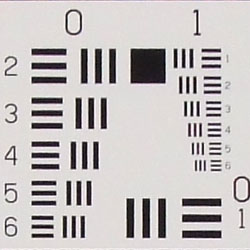
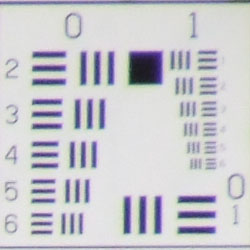
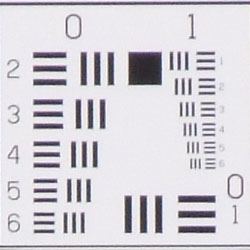
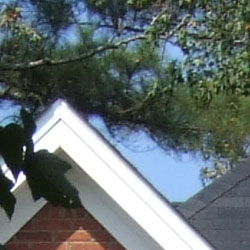
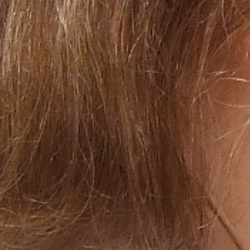

Follow Imaging Resource: